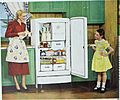Cult of domesticity facts for kids
The Cult of Domesticity was a popular idea in the 1800s, especially in the United States and Great Britain. It was also called the Cult of True Womanhood. This idea suggested that a woman's main role was to be a homemaker and stay at home. People who believed in this idea thought women should not work outside the home.
Contents
What They Believed Women Should Be
Followers of the Cult of Domesticity believed women should have four main qualities:
- Piety: This meant women should be more religious and spiritual than men. They were seen as the moral guides of the family.
- Purity: Women were expected to be pure in their heart and mind. This meant they should be innocent and good.
- Submissiveness: Women were encouraged to be gentle and follow the lead of their husbands. They were seen as supportive partners.
- Domesticity: This was the belief that a woman's place was in the home. Her main job was to manage the household, raise children, and create a peaceful space for her family.
When Was This Idea Popular?
The idea of domesticity began to be practiced around the 1820s. However, it became very popular and widely followed in the 1840s and 1850s. This way of thinking started to fade after the American Civil War ended around 1865. People's beliefs changed as society evolved.
Impact on Education
The Cult of Domesticity often discouraged women from getting a formal education. The main focus was on their roles as wives and mothers. While some believed this idea raised women's moral standing and offered a comfortable life, it limited their opportunities outside the home. It made the roles of being a wife and a mother seem the most important in society.
Images for kids
-
Godey's Lady's Book was a very popular women's magazine that supported the values of the Cult of Domesticity.
-
A New Court of Queen's Bench, an 1849 cartoon by George Cruikshank, making fun of the idea of women working in law courts.




